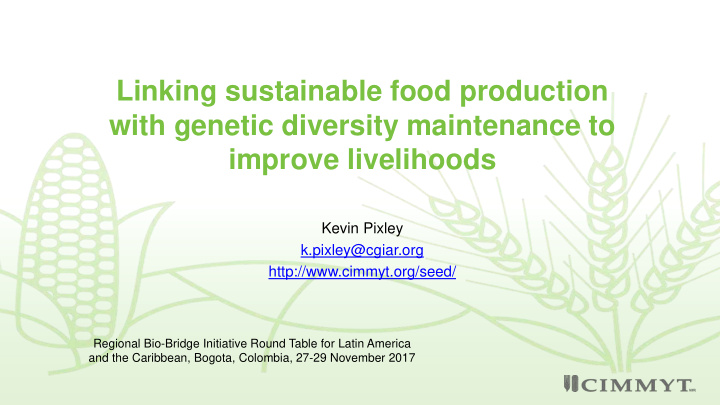



Linking sustainable food production with genetic diversity maintenance to improve livelihoods Kevin Pixley k.pixley@cgiar.org http://www.cimmyt.org/seed/ Regional Bio-Bridge Initiative Round Table for Latin America and the Caribbean, Bogota, Colombia, 27-29 November 2017
Shared Vision: – Sustainable agriculture – Food and nutrition security for all – Biodiversity conservation – Poverty alleviation – improved livelihoods
The Problem • Growing population Increasing food demand • Competition for limited land area – Food production – Biodiversity conservation – (of course, other uses) • Need to achieve ‘safe operating space’ for humanity GEF 2020: Strategy for the GEF
Towards a Solution: Forge synergies – Biodiversity conservation – Sustainable agricultural intensification • Reduced, stopped, or reversed land expansion • Reduced environmental footprint • Increased productivity and food security Multi-sectoral partnerships – Agriculture – Environment – Economics… Develop options, facilitate, incentivize, advocate change
Actions: • Consultatively develop indicators of farming system sustainability and productivity that meet productivity and environmental health objectives (Aichi targets 2, 3, 4, 5 and 7); • Evaluate genetic diversity and incorporate indicators of agricultural biodiversity into farming system assessments (Aichi 13, 19); • Discuss and elaborate models for incentive programs to enhance synergies between sustainable agricultural intensification, biodiversity conservation and improved livelihoods (Aichi 2 and 3); • Build synergistic partnerships to conserve ecosystems for biodiversity conservation by sustainably increasing the productivity of farming systems (Aichi 7, 14)
CIMMYT’s Expertise: • Agriculture, especially related to maize and wheat systems • Conservation, characterization and use of crop genetic resources • Sustainable agricultural intensification • Participatory development and evaluation of farming technology options • Socio-economic assessment of agricultural value chains and livelihood opportunities
CIMMYT’s Experience: Genetic Diversity Moises Morales, Univ. de Guadalajara* Elotes occidentales CIMMYT (collected 1960s) Ears with 8-10 kernel rows; large grains; floury, purple grains Univ. Guadalajara *Centro de Conservación de Recursos (collected 2003) Fitogenéticos en el Occidente de México BANCO DE GERMOPLASMA CUCBA
CIMMYT’s Experience: Residue burning and its impacts A growing problem in Northern India – ≈23 Mt of rice residue are burned each winter. – Only ≈20 % is recycled. – Rice waste burning results in air pollution. – Soil organific levels are half of historic levels – Losses of soil nutrients – Groundwater levels are declining – Burning contributes to climate change. • accelerated snowpack melting in the Himalayas • changes in monsoon patterns
Key Elements of the Strategy: • • Close the knowledge gap that exists Provide attractive subsidy and loan capital regarding Happy Seeders among farmers, to incentify private sector implementation. government, and NGOs. • Align policy and government support • Encourage the growth of service providers systems - extension and KVKs around this supporting Happy Seeder implementation. solution.
CIMMYT - technical and scientific cooperation to: Thank you for your interest! Kevin Pixley k.pixley@cgiar.org http://www.cimmyt.org/seed/
Recommend
More recommend